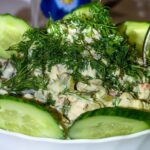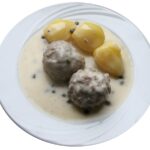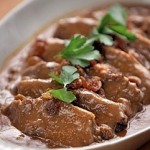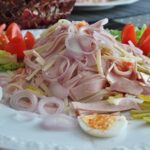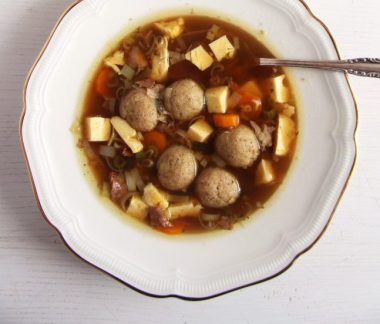 Typical German beef soup with bone marrow dumplings, vegetables, noodles and egg custard, so comforting and delicious!
Typical German beef soup with bone marrow dumplings, vegetables, noodles and egg custard, so comforting and delicious!
Ingredients:
2 large bread rolls
2 1⁄2 cups bread crumbs
1⁄2 cup finely chopped parsley
2 eggs
freshly grated nutmeg, to taste
Kosher salt and freshly ground black pepper, to taste
0.5 kg beef marrow bones
10 cups beef stock
1 small carrot, peeled and finely chopped
1 small leek, white and light green parts only, finely chopped
For the egg custard:
4 eggs
120 ml/ ½ cup milk
½ teaspoon salt
a pinch of nutmeg
Preparation:
- Make the custard: mix the eggs, milk, salt and nutmeg very well. Pour the mixture in a freezer bag, knot the bag very tightly. Bring a medium pot of water to a boil, lower the heat, place the bag with the eggs in the pot and simmer gently for about 15-20 minutes, turning the bag a few times in between, until the eggs are completely set. Take out of the water, let cool for a while, remove the bag, slice the eggs thickly, then chop them into small squares or diamonds. Add to the soup during the last cooking minutes.
- Make the dumplings: place rolls in a bowl and pour warm water over them and let sit until soft, about 30 minutes. Drain and squeeze completely dry. Using your fingers, crumble rolls into a medium bowl. Add bread crumbs, 6 tbsp. parsley, eggs, nutmeg, and salt and pepper; set aside.
- Using a small spoon or butter knife, scoop marrow from bones into a small saucepan; heat over medium heat until melted. Pour into bowl with rolls and mix until dough forms. Shape into about thirty 1-oz. balls; set aside.
- Mix stock, carrots and leek in a 6-qt. saucepan, season with salt and pepper. Bring to a boil over medium-high heat; reduce heat to medium, and add dumplings. Cook, stirring occasionally, until dumplings are cooked through, about 3 minutes.
- To serve, ladle soup and dumplings into bowls, and garnish with remaining parsley.

